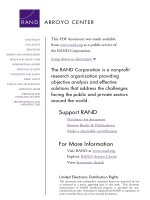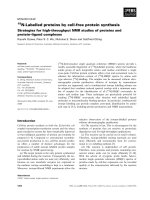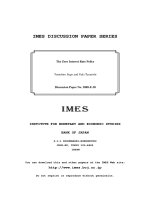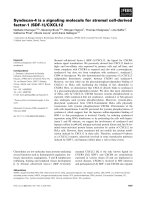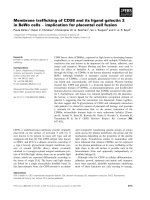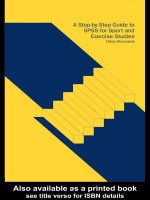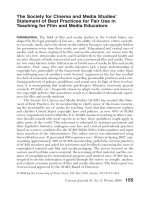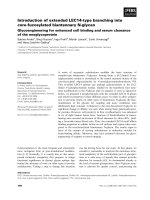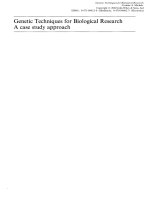Force controlled biomanipulation for biological cell mechanics studies
Bạn đang xem bản rút gọn của tài liệu. Xem và tải ngay bản đầy đủ của tài liệu tại đây (4.1 MB, 181 trang )
Force-controlled Biomanipulation for
Biological Cell Mechanics Studies
Nam Joo Hoo
(B. Tech., NUS)
A thesis submitted
for the degree of Doctor of Philosophy
Department of Mechanical Engineering
National University of Singapore
2011
Acknowledgments
This thesis would not have been possible without the guidance and support of
many people who in one way or another contributed and extended their valuable
assistance in the preparation and completion of this study.
I am heartily thankful to my supervisor, Asst. Prof. Peter Chen Chao Yu from
Department of Mechanical Engineering, National University of Singapore, and
my co-supervisor, Dr. Lin Wei from Singapore Institute of Manufacturing Tech-
nology (SIMTech), for their invaluable encouragement, enthusiasm and guid-
ance from the initial to the final level of this project. Without their knowledge
and support, this thesis would not have been successful.
I would like to express my appreciation to Dr. Yang Guilin, Dr. Luo Hong, Dr.
Lin Wenjong, Dr. Chen Wenjie, Ms. Lu Haijing, Mr. Ng Chuen Leong, Mr.
Wong Lye Seng and all other staffs from SIMTech, for sharing their knowledge
and invaluable assistance.
Special thanks also to Prof. Franck Alexis Chollet, Mr. Hoong Sin Poh, Mr.
Wong Kim Chong, Mr. Pek Soo Siong, Mr. Ho Kar Kiat, Mr. Nordin Bin Abdul
Kassim and all others staffs from Micromachines Lab, Nanyang Technological
University, for their technical guidance and assistance.
I would like to thank A/P Ge RuoWen, Mr. Yan Tie, Mr. Subhas Balan, Miss Li
i
ACKNOWLEDGMENTS
Yan and Mr. Nilesh Kumar Mahajan from Department of Biological Science,
National University of Singapore, for preparation of the zebrafish embryos and
micropipettes.
Last but not the least, I wish to thank all my fellow colleagues, especially group
members; Lu Zhe, Zhou Shengfeng, Sahan Christie Bandara Herath, Yang Tao,
Chua Yuanwei, Nellore Sri Vittal and all the staffs from Control and Mechatron-
ics Lab, for their friendship, assistance and kindness.
Finally, my deepest gratitude goes to my beloved wife and families, for their
understanding, emotional support and endless love, through the duration of my
studies.
I would like to acknowledge the financial support from the Singapore Ministry
of Education under research grant R265000249112.
Lastly, I would like to take this opportunity to offer my regards and blessings
to all of those who supported me in any respect during the completion of the
thesis.
ii
Table of Contents
Acknowledgments i
Table of Contents iii
Summary vii
Publications x
List of Tables xiii
List of Figures xiv
1 Introduction 1
1.1 Mechanobiology, Mechanosensing and Mechanotransduction . . 2
1.1.1 Mechanoinduced Variation in Cellular Properties . . . . 4
1.2 The needs of force sensing and control in biomanipulation . . . 7
1.3 Motivation and Objectives . . . . . . . . . . . . . . . . . . . . 10
1.4 Organization of the thesis . . . . . . . . . . . . . . . . . . . . . 15
iii
TABLE OF CONTENTS
2 Background and Literature Review 17
2.1 Mechanosensors . . . . . . . . . . . . . . . . . . . . . . . . . . 18
2.1.1 Membrane Potential . . . . . . . . . . . . . . . . . . . 22
2.1.2 Surface Charge and Double Layer . . . . . . . . . . . . 24
2.2 Zebrafish Chorion Architecture . . . . . . . . . . . . . . . . . . 26
2.3 Devices and Techniques for Mechanotransduction Study . . . . 30
2.3.1 Atomic Force Microscope (AFM) . . . . . . . . . . . . 31
2.3.2 Microelectromechanical (MEMS) . . . . . . . . . . . . 33
2.3.3 Micropipette Aspiration . . . . . . . . . . . . . . . . . 35
2.4 Concluding Remarks . . . . . . . . . . . . . . . . . . . . . . . 37
3 The Viscoelastic Nature of Zebrafish Chorion 39
3.1 Introduction . . . . . . . . . . . . . . . . . . . . . . . . . . . . 40
3.2 Linear Viscoelastic Models . . . . . . . . . . . . . . . . . . . . 42
3.2.1 Maxwell Model . . . . . . . . . . . . . . . . . . . . . . 44
3.2.2 Voigt Model . . . . . . . . . . . . . . . . . . . . . . . 46
3.2.3 The Maxwell-Weichert Model . . . . . . . . . . . . . . 48
3.3 Viscoelastic Model of Zebrafish Chorion . . . . . . . . . . . . . 51
3.3.1 Experiment Setup . . . . . . . . . . . . . . . . . . . . . 51
3.3.2 Results . . . . . . . . . . . . . . . . . . . . . . . . . . 55
3.3.3 Discussion . . . . . . . . . . . . . . . . . . . . . . . . 56
3.4 Concluding Remarks . . . . . . . . . . . . . . . . . . . . . . . 59
iv
TABLE OF CONTENTS
4 Explicit Force-feedback Controlled System 60
4.1 Introduction . . . . . . . . . . . . . . . . . . . . . . . . . . . . 61
4.2 Explicit Force-Controlled System for Mechanotransduction . . . 62
4.2.1 Force Generation . . . . . . . . . . . . . . . . . . . . . 63
4.2.2 Force Transmission . . . . . . . . . . . . . . . . . . . . 64
4.2.3 Force Sensing . . . . . . . . . . . . . . . . . . . . . . . 77
4.3 Force Control . . . . . . . . . . . . . . . . . . . . . . . . . . . 82
4.3.1 Dynamic Model of Force Transmission stage . . . . . . 82
4.3.2 PID Explicit Force Control . . . . . . . . . . . . . . . . 82
4.3.3 Robust Explicit Force Control . . . . . . . . . . . . . . 86
4.4 Concluding Remarks . . . . . . . . . . . . . . . . . . . . . . . 95
5 Mechano-induced Change in Electrical Property of Cellular Organ-
ism: Variation in Impedance of Zebrafish Embryos by Explicit Force
Feedback Control 99
5.1 Introduction . . . . . . . . . . . . . . . . . . . . . . . . . . . . 100
5.2 Motivation and Objective . . . . . . . . . . . . . . . . . . . . . 101
5.3 Materials and Methods . . . . . . . . . . . . . . . . . . . . . . 102
5.3.1 Collection of Zebrafish Embryos . . . . . . . . . . . . . 102
5.3.2 Electrochemical Impedance Measurement . . . . . . . . 103
5.3.3 Force Control . . . . . . . . . . . . . . . . . . . . . . . 112
5.4 Results and Discussion . . . . . . . . . . . . . . . . . . . . . . 112
5.5 Concluding Remarks . . . . . . . . . . . . . . . . . . . . . . . 117
v
TABLE OF CONTENTS
6 Mechano-induced Change in Mechanical Property of Cellular Or-
ganism: Reduction in Zebrafish Chorion Stiffness by External Pertur-
bation 119
6.1 Introduction . . . . . . . . . . . . . . . . . . . . . . . . . . . . 120
6.2 Motivation . . . . . . . . . . . . . . . . . . . . . . . . . . . . . 122
6.3 Materials and Methods . . . . . . . . . . . . . . . . . . . . . . 123
6.3.1 Young’s Modulus Determination . . . . . . . . . . . . . 123
6.3.2 Force Control . . . . . . . . . . . . . . . . . . . . . . . 124
6.3.3 Methodology . . . . . . . . . . . . . . . . . . . . . . . 125
6.4 Results and Discussion . . . . . . . . . . . . . . . . . . . . . . 126
6.4.1 Influences of Step Perturbation on the Stiffness of Ze-
brafish Chorion . . . . . . . . . . . . . . . . . . . . . . 126
6.4.2 Influences of Periodic Forces on the Stiffness of Ze-
brafish Chorion . . . . . . . . . . . . . . . . . . . . . . 131
6.5 Concluding Remarks . . . . . . . . . . . . . . . . . . . . . . . 135
7 Conclusion and Future Direction 138
7.1 Concluding Discussion . . . . . . . . . . . . . . . . . . . . . . 139
7.2 Contribution . . . . . . . . . . . . . . . . . . . . . . . . . . . . 142
7.3 Future Direction . . . . . . . . . . . . . . . . . . . . . . . . . . 145
Bibliography 147
vi
Summary
Constantly exposed to various forms of mechanical forces inherent in their phys-
ical environment, cellular organisms are able to sense such forces and con-
vert them into biochemical signals through the processes of mechanosensing
and mechanotransduction. The two processes eventually lead to physiological
and pathological changes in their internal structures and activities. The effect
might manifest in changes of the physiological properties, such as stiffness and
impedance, of the organism. This suggests that timely application of appropri-
ate external forces may be used as a means to directly manipulate the dynamics
of the internal processes (e.g., cell division and gene expression) of a cellular or-
ganism, which leads to the ultimate objective of mechano-control of biological
systems.
Quantitativeinvestigation of how cellular organisms respond to mechanical force
requires proper sensing and control of an applied mechanical force to the or-
ganisms and simultaneously measure changes in their physiological properties.
However, an engineering challenge remain in explicitly controlling the applied
force to achieve force regulation and trajectory tracking without causing dam-
age to the internal or external structures of the organism. This thesis explores
the development of an explicit force-controlled system which is capable of ap-
plying and controlling a prescribed force on a zebrafish embryo accurately. The
vii
SUMMARY
established explicit force-controlled system consists of a linear voice-coil actua-
tor for force generation, a micro-indenter equipped with a piezoresistive micro-
force sensor for applying a prescribed force on the cellular surface, and a com-
pound flexure stage for transmitting the force from the voice coil actuator to the
micro-indenter. The interaction force between the micro-indenter and the cellu-
lar surface is measured and feedback to the controller by the micro-force sensor.
The explicit force-controlled system is able to apply an indentation force that
can be controlled in magnitude and different types of force trajectory (e.g., step,
sinusoidal, and rectangular), with various durations or frequencies, directly on
the zebrafish embryo.
In this thesis, a series of experiments have been conducted to detect and in-
vestigate, in a quantitative manner, the mechano-induced variation in the phys-
iological properties of a zebrafish chorion. The purpose of this thesis is not
to explain how any particular mechanotransduction pathway is operated, but
rather to explore the dynamic changes in the physiological properties (e.g., the
real-time force-induced variation in the stiffness and impedance) of a cellular
organism when the organism encounters changes in its external loadings from
its mechanical environment, especially in the dynamics of the cellular responses
to indentation force.
The experimental data provides evidence supporting the hypothesis that certain
physiological properties of some cellular organisms can be modified by apply-
ing an appropriate mechanical force. The findings provide a basic milestone for
future study to reveal the correlation between the changes in cellular physio-
logical properties and the possible signalling pathways of the organisms (e.g.,
the zebrafish embryo) in response to an external mechanical force. To the best
knowledge of the author, no studies of the dynamics behaviours and influence
viii
SUMMARY
of the external forces, of different rates or frequencies, on the physiological
properties of zebrafish embryos were previously undertaken. The experimental
setup and method proposed in this thesis therefore provide a useful approach
for the study of the interactions involving the rheological and physical prop-
erties of a cellular organism. Moreover, it is now an important emerging area
of research in mechanotransduction, and the approach proposed in this thesis
could also be used to study the mechanism of cellular biomechanical response
and signal transduction pathway in more detail, which ultimately may allow the
clinicians to alter the biological functions and disease properties by applying
suitable mechanical force directly, leading to a new strategy for treatment.
ix
Publications
Journal Publications
1. Peter Chen C. Y., Nam Joo Hoo, Lu Zhe, Luo Hong, Ge Ruowen, Lin
Wei, ”Effect of Localized External Mechanical Forces on the Stiffness of
Zebrafish Chorion”. Submitted to Journal of Biomechanics, Feb, 2012
2. Nam Joo Hoo, Peter Chen C. Y., Lu Zhe, Luo Hong, Ge Ruowen, and
Lin Wei, ”Force Control for Mechanotransduction of Impedance Varia-
tion in Cellular Organisms”. Published in Journal of Micromechanics and
Microengineering, vol. 20, 2010
3. Lu Zhe, Peter Chen C. Y., Nam Joo Hoo, Ge Ruowen, and Lin Wei, ”A
Micromanipulation System with Dynamic Force-feedback for Automatic
Batch Microinjection”. Published in Journal of Micromechanics and Mi-
croengineering, vol. 17, 2007
4. Lu Zhe, Peter Chen C. Y., Anand Ganapathy, Guoyong Zhao, Nam Joo
Hoo, Yang Guilin, Etienne Burdet, Teo Chee Leong, Meng Qingnian, and
Lin Wei ”A Force-feedback Control System for Micro-assembly”. Pub-
lished in Journal of Micromechanics and Microengineering, vol. 16, 2006
x
PUBLICATIONS
Conference Publications
1. Nam Joo Hoo, Peter Chen C. Y., Lu Zhe, Luo Hong, Ge Ruowen, and
Lin Wei, ”Mechanoinduction of Reduction in the Stiffness of Zebrafish
Chorion”. Published in Proceedings of IEEE International Conference on
Control, Automation, Robotics and Vision (ICARCV), 2010.
2. Zhou Shengfeng, Peter Chen C. Y., Lu Zhe, Nam Joo Hoo, Luo Hong,
Ge Ruowen, Ong Chong Jin, and Lin Wei, ”Speed Optimization for Mi-
cropipette Motion during Zebrafish Embryo Microinjection”. Published
in Proceedings of IEEE International Conference on Control, Automation,
Robotics and Vision (ICARCV), 2010.
3. Luo Hong, Nam Joo Hoo, Peter Chen C. Y., Lin Wei, Lim Chee Wang,
and Yang Guilin, ”A Micro Force Measurement, Transmission and Con-
trol System for Biomechanics Studies”. Published in Proceedings of In-
ternational Conference of the European Society for Precision Engineering
& Nanotechnology (euspen), 2010.
4. Nam Joo Hoo, Peter Chen C. Y., Lu Zhe, Luo Hong, Ge Ruowen, and Lin
Wei, ”Induction of Variation in Impedance of Zebrafish Embryos by Ex-
plicit Force Feedback Control”, Published in Proceedings of IEEE Con-
ference on Robotics and Biomimetics (ROBIO), 2009. Finalist for Best
Student Paper Award.
5. Luo Hong, Lu Zhe, Nam Joo Hoo, Peter Chen C. Y., and Lin Wei, ”Evalu-
ation of Wire Bond Integrity through Force Detected Wire Vibration Anal-
ysis” Published in IEEE/ASME International Conference on Advanced
Intelligent Mechatronics (AIM), 2009.
xi
PUBLICATIONS
6. Lu Zhe, Peter Chen C. Y., Nam Joo Hoo, Ge Ruowen, and Lin Wei, ”A mi-
cromanipulation system for automatic batch microinjection”. Published
in Proceedings of IEEE International Conference on Robotics and Au-
tomation (ICRA), 2007.
xii
List of Tables
3.1 Viscoelastic parameters of different embryos. . . . . . . . . . . 58
4.1 Values of system parameters. . . . . . . . . . . . . . . . . . . . 83
4.2 Parameter values for robust explicit force-controlled system. . . 96
5.1 Force-induced changes in resistance and capacitance of zebrafish
chorion . . . . . . . . . . . . . . . . . . . . . . . . . . . . . . 117
6.1 Changes in viscoelastic parameters of zebrafish chorion sub-
jected to step force . . . . . . . . . . . . . . . . . . . . . . . . 127
6.2 Changes in viscoelastic parameters of zebrafish chorion sub-
jected to rectangular-wave force . . . . . . . . . . . . . . . . . 133
6.3 Changes in viscoelastic parameters of zebrafish chorion sub-
jected to sinusoidal periodic force . . . . . . . . . . . . . . . . 135
xiii
List of Figures
2.1 A schematic illustration of mecahnotransduction mechanism (Adapted
from [1]). . . . . . . . . . . . . . . . . . . . . . . . . . . . . . 19
2.2 Activation mechanism of mechanosensitive ion channels: (a)
The tension developed in the biomembrane directly triggers the
channels. (b) Displacement of the extracellular matrix or the
cytoskeleton relative to the ion channel triggers the channel to
open or close (Adapted and redrawn from [2]). . . . . . . . . . 21
2.3 Schematic illustration of hair-cell transduction mechanism: When
the stereocilia is tipped toward by its neighbouring stereocilia,
the tip link pulls on and opens the ion channel. Movement in the
opposite direction relaxes the tip link so that any open channels
will close (Adapted and redrawn from [3]). . . . . . . . . . . . 21
xiv
LIST OF FIGURES
2.4 A neuro-transmission process in presynaptic cell (a) The neuro-
transmitter is stored in vesicles in a resting state. (b) An action
potential leads to influx of Ca
2+
into the presynaptic cell. Con-
sequently, this releases the neurotransmitter into the synaptic
cleft. (c) The neurotransmitter diffuses across the synaptic cleft
and binds to receptors on the surface of the postsynaptic cell.
The ion channel opens and there is an influx of Na
+
ions into
the postsynaptic cell (Adapted from [4]). . . . . . . . . . . . . . 22
2.5 Schematic representation of bilayer lipid membrane (Adapted
and redrawn from [5]). . . . . . . . . . . . . . . . . . . . . . . 23
2.6 Schematic diagram illustrates the progression in the develop-
ment of membrane potential. . . . . . . . . . . . . . . . . . . . 24
2.7 Negative charges from an electrode neutralize positive surface
charges and form a double layer (Adapted and redrawn from [6]). 26
2.8 Picture of an adult zebrafish (Adapted from [7]). . . . . . . . . . 27
2.9 The development cycle of: (a) Zebrafish embryo and (b) Human
embryo. . . . . . . . . . . . . . . . . . . . . . . . . . . . . . . 27
2.10 Structure of a zebrafish embryo. . . . . . . . . . . . . . . . . . 28
2.11 Model of zona pellucida as postulated by [8] and redrawn from [9]. 29
2.12 Structure of the zebrafish chorion (adapted and redrawn from
[10]). Z1: outer layer, Z2: middle layer, Z3: inner layer, P: pore
canal, PP: pore plug. . . . . . . . . . . . . . . . . . . . . . . . 29
2.13 Schematic setup diagram of Atomic Force Microscopic (AFM)
(Adapted from [11]). . . . . . . . . . . . . . . . . . . . . . . . 32
xv
LIST OF FIGURES
2.14 Schematic illustration of experimental method using AFM to
probe the mechanical properties of biological cells. . . . . . . . 33
2.15 Schematic drawing of one-component force sensor developed
by [12] (Adapted from [13]). . . . . . . . . . . . . . . . . . . . 34
2.16 Schematics illustration of capacitive force sensor (Adapted from
[14]). . . . . . . . . . . . . . . . . . . . . . . . . . . . . . . . 35
2.17 Schematic showing a biological cell being aspirated in to a mi-
cropipette with a suction pressure. . . . . . . . . . . . . . . . . 36
2.18 Line scan of three examples of mitotic cells showing the myosin-
II redistributes to the site of cell deformation when subjected to
a micropipette aspiration (Adapted from [15]). . . . . . . . . . . 37
3.1 Force vs displacement curve of the penetration process for ze-
brafish embryos. . . . . . . . . . . . . . . . . . . . . . . . . . . 42
3.2 The Maxwell model. . . . . . . . . . . . . . . . . . . . . . . . 45
3.3 Stress relaxation of the Maxwell model held at constant strain. . 46
3.4 The Voigt viscoelastic model. . . . . . . . . . . . . . . . . . . . 47
3.5 A typical creep of the Voigt model under a constant stress. . . . 48
3.6 Maxwell-Weichert model having two Maxwell elements. . . . . 51
3.7 Schematic illustration of (a) the overall micromanipulation sys-
tem and (b) the small pool area. . . . . . . . . . . . . . . . . . . 52
3.8 (a) Close-up view of the contact between the micropipette and
the embryo. (b) Indentation of the zebrafish embryo membrane
by a micropipette. . . . . . . . . . . . . . . . . . . . . . . . . . 54
xvi
LIST OF FIGURES
3.9 Viscoelasticity of zebrafish embryo with indentation displace-
ment of (a) 180
µ
m and (b) 300
µ
m. . . . . . . . . . . . . . . . 55
3.10 Force trajectory of the indentation of the zebrafish embryo. . . . 56
3.11 Experimental force relaxation and curves fitting results for four
zebrafish embryos(Blue-solid line - experimental results, Red-
dash line - fitting curves). . . . . . . . . . . . . . . . . . . . . . 57
3.12 Curve fitting of force trajectory of the indentation of the ze-
brafish embryo. . . . . . . . . . . . . . . . . . . . . . . . . . . 58
4.1 Explicit force-feedback control system for exerting an indenta-
tion force on an embryo. (a) Overall view. (b) Isometrics view. . 63
4.2 (a) A typical voice coil actuator from Servo Magnetics Inc. (b)
A current supply to magnetic coil causing movable core move
axially. . . . . . . . . . . . . . . . . . . . . . . . . . . . . . . . 64
4.3 Examples of compliant mechanism (redrawn and adapted from
[16]). . . . . . . . . . . . . . . . . . . . . . . . . . . . . . . . 66
4.4 Simple cantilever beam. . . . . . . . . . . . . . . . . . . . . . . 67
4.5 Parallelogram flexure. . . . . . . . . . . . . . . . . . . . . . . . 68
4.6 Lens guiding mechanism (Adapted from [17]). . . . . . . . . . 69
4.7 A compound leaf spring mechanism. (Adapted from [18]) . . . 70
4.8 The force transmission flexure stage. (a) Structure. (b) Dimension. 71
4.9 Mode of operation of the compound leaf spring mechanism:
rectilinear motion is produced by the cancellation between the
parasitic error of both platforms. . . . . . . . . . . . . . . . . . 72
xvii
LIST OF FIGURES
4.10 Schematic block diagram of the flexure stage. . . . . . . . . . . 73
4.11 Results of calibration for force transmission stage . . . . . . . . 74
4.12 Hysteresis curve of the force transmission flexure stage. . . . . . 76
4.13 A typical piezoresistive force sensor. . . . . . . . . . . . . . . . 78
4.14 A typical commercial piezoresistivemicro-force sensor. (Adapted
from [19]) . . . . . . . . . . . . . . . . . . . . . . . . . . . . . 80
4.15 Schematic depicts the deflection of a piezoresistive force sensor
to a load f
s
(Adapted from [19]) . . . . . . . . . . . . . . . . . 80
4.16 Schematic showing zebrafish chorion indented by a micro-indenter. 81
4.17 Modified micro-force sensor with micro-indenter. . . . . . . . . 81
4.18 Dynamics model of the flexure stage. . . . . . . . . . . . . . . . 83
4.19 Closed-loop force control system . . . . . . . . . . . . . . . . . 86
4.20 Step response of the PID controlled system . . . . . . . . . . . 86
4.21 Response of the PID controlled system to a sinusoidal force tra-
jectory . . . . . . . . . . . . . . . . . . . . . . . . . . . . . . . 87
4.22 Block diagram for robust explicit force control . . . . . . . . . . 96
4.23 Step-response of the robust explicit force control system . . . . 96
4.24 The force response of the robust explicit force control system to
a sinusoidal force trajectory. . . . . . . . . . . . . . . . . . . . 97
5.1 Transfer charges between an electrode and ions on chorion mem-
brane causing current flow. . . . . . . . . . . . . . . . . . . . . 104
xviii
LIST OF FIGURES
5.2 Parallel-RC circuit model and circuit for measuring electrochem-
ical impedance. . . . . . . . . . . . . . . . . . . . . . . . . . . 105
5.3 Current response to a sinusoidal voltage. . . . . . . . . . . . . . 106
5.4 Current flow in a parallel-RC circuit. . . . . . . . . . . . . . . . 108
5.5 Illustration of impedance measurement setup: (a) Isometric view.
(b) Schematic isometric view. . . . . . . . . . . . . . . . . . . . 111
5.6 Illustration of explicit force-feedback system: (a) Plan view. (b)
Schematic plan view. . . . . . . . . . . . . . . . . . . . . . . . 113
5.7 Measured impedance of an unperturbed zebrafish embryo. . . . 114
5.8 Two results showing the impedance dropped after force applied
at around 600sec. . . . . . . . . . . . . . . . . . . . . . . . . . 115
5.9 Two results showing the impedance increased after force ap-
plied at around 600sec. . . . . . . . . . . . . . . . . . . . . . . 116
6.1 Overall view of experimental setup. . . . . . . . . . . . . . . . 123
6.2 A closed view of experimental setup. . . . . . . . . . . . . . . . 126
6.3 Indenting the zebrafish chorion with a micro-indenter. . . . . . . 126
6.4 Force response curves (in respected to a displacement of 150
µ
m)
of zebrafish chorion perturbed by a step perturbation with mag-
nitude of 100
µ
N and perturbation time of (a) 30 seconds. (b) 40
seconds. (c) 1 minute (d) 2 minutes and (e) 3 minutes. (Square-
solid line - initial measurement. Triangle-dash line - measure-
ment taken after perturbation) . . . . . . . . . . . . . . . . . . 128
xix
LIST OF FIGURES
6.5 Reduction in Young’s modulus of zebrafish chorion subjected to
various perturbation times . . . . . . . . . . . . . . . . . . . . 129
6.6 Force response curve (in respected to a displacement of 150
µ
m)
for unperturbed embryos. (Square-solid line - initial measure-
ment. Triangle-dash line - measurement taken after (a) 40 sec-
onds and (b) 10 minutes) . . . . . . . . . . . . . . . . . . . . . 129
6.7 Force response curves (in respected to a displacement of 150
µ
m)
of a zebrafish chorion after being allowed to be kept in its unper-
turbed state for around 100 seconds, 340 seconds, 820 seconds
and 1780 seconds after a perturbation. . . . . . . . . . . . . . . 131
6.8 Force response curve (in respected to a displacement of 150
µ
m)
of a zebrafish chorion which was further perturbed by a step per-
turbation with magnitude of 100
µ
N for 40 seconds. (Square-
solid line - initial measurement. Triangle-dash line - measure-
ment taken after first perturbation. Circle-dash line - measure-
ment taken after second perturbation) . . . . . . . . . . . . . . 131
6.9 Two types of periodic force: (a) Rectangular-wave periodic force
trajectory and (b) Sinusoidal periodic force trajectory . . . . . . 132
6.10 Force response curves (in respected to a displacement of 150
µ
m)
of zebrafish chorion subjected to a rectangular-wave force tra-
jectory with (a) T
On
of 10sec T
Of f
of 10sec and duration of
3mins. (b) T
On
of 10sec T
Of f
of 30sec and duration of 3mins. (c)
T
On
of 10sec T
Of f
of 40sec and duration of 5mins. and (d) T
On
of 10sec T
Of f
of 50sec and duration of 5mins. (Square-solid line
- initial measurement. Triangle-dash line - measurement taken
after perturbation) . . . . . . . . . . . . . . . . . . . . . . . . . 133
xx
LIST OF FIGURES
6.11 Force response curves (in respected to a displacement of 150
µ
m)
of zebrafish chorion subjected to a sinusoidal force trajectory
with (a) T of 50sec and duration of 3mins. (b) T of 20sec
and duration of 3mins. (c) T of 3.3sec and duration of 5mins.
(d) T of 1.3sec and duration of 5mins. and (e) T of 1.15sec
and duration of 5mins. (Square-solid line - initial measurement.
Triangle-dash line - measurement taken after perturbation) . . . 134
6.12 Reduction in Young’s modulus of zebrafish subjected to various
of (a) space width, T
Of f
of rectangular-wave periodic perturba-
tion, and (b) frequency of sinusoidal periodic force. . . . . . . . 136
xxi
Chapter 1
Introduction
1
1.1 Mechanobiology, Mechanosensing and Mechanotransduction
1.1 Mechanobiology, Mechanosensing and Mechan-
otransduction
Constantly exposed to various forms of mechanical forces inherent in their phys-
ical environment (such as gravity, stress induced by fluid flow, pressure, stretch,
compression, cell-cell interactions, etc.), cellular organisms are able to sense
such forces and convert them into biochemical signals through the processes
of mechanosensing and mechanotransduction. These two processes eventually
lead to physiological and pathological changes in their properties, structures,
and biological functions. This suggests that timely application of appropriate
external forces may be used as a means to directly manipulate the dynamics of
the internal processes (e.g., cell division and gene expression) of a cellular or-
ganism, which leads to the ultimate objective of mechano-control of biological
systems.
It has been known for over a century that mechanical forces directly affect the
biological structures of the human body. In 1892, researchers have started to
realise that the healthy bone changes its matrix in a distinct pattern map in
line with the tension or compression load exerted on the bone [20], e.g., the
Wolff’s law (by Julius Wolff (1836-1902)). However, mechanical forces have a
far greater impact on cellular functions than previously deemed. Physiologists
and clinicians now recognise that mechanical forces serve as critical bioreg-
ulators of certain biological functions, such as gene expression, cell motility,
growth, death, proliferation, and differentiation [1,21]. Nevertheless, abnormal
forces applied to the cellular organisms (e.g., due to the failure of mechanotrans-
duction process) may destabilise the cellular structures and functions that may
lead to a formation of numerous tissue or organ pathologies including cancer,
2
1.1 Mechanobiology, Mechanosensing and Mechanotransduction
hypertension, and osteoarthritis [21]. For example, in cytokinesis (cell divi-
sion process), successful cell division has been regarded as critical to human
health. Any external force applied to cells must be properly adjusted or bal-
anced through mechanotransduction process. Failure in mechanotransduction
can contribute to formation of tumorigenic cells [22].
Mechanotransduction is the process by which cellular organisms respond to
external mechanical forces [23]. Many experiments have shown that cellular
organisms may change their internal structures and activities in response to
external forces. Specific experimental studies include the myosin-II redistri-
bution in dictyostelium cell when aspirated by micropipette [15], the remod-
elling of the actin network in monkey kidney fibroblast under a lateral defor-
mation [12], the increases in voltage-gated K
+
current when an endothelial cell
was stretched [24], and the change in
β
-actin gene expression of heart and no-
tochord of a transgenic zebrafish after exposure to simulated microgravity [25].
Other experiments [26–28] have also demonstrated that the mechanical forces
could alter gene expression and differentiation of a stem cell.
Despite the fact that many mechanotransduction pathways have been exten-
sively identified, the basic mechanism by which a cellular organism changes
its behaviours or intrinsic properties in response to mechanical forces remains
enigmatic. However, it is widely accepted that these mechanotransduction path-
ways normally start from a cellular mechanism located within the membrane
surface of cellular organism. Many recent examples [29–31] have shown that
the initial response of a cellular organism to an external mechanical force occurs
at the membrane and mediates many of the downstream cellular processes.
Different types of organisms may employ different mechanisms to sense and
3
